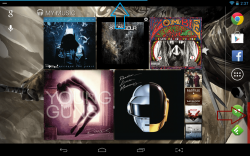 Minimalism is all about being subtle, yet stylish. The idea is to break something down to its simplest form, thus exposing pure beauty. Minimal is an especially beneficial concept when you start talking about the mobile field. Unfortunately, there are necessary elements of a mobile OS like Android that aren’t exactly minimal, in either the sense that they’re not subtle or even that they’re not stylish. Take some of the status bar indicators for example, like the battery percentage or Wi-Fi signal strength icons. PowerLine is an Android application which changes the on-screen indicators for some of those components in a very subtle, yet stylish way.
Minimalism is all about being subtle, yet stylish. The idea is to break something down to its simplest form, thus exposing pure beauty. Minimal is an especially beneficial concept when you start talking about the mobile field. Unfortunately, there are necessary elements of a mobile OS like Android that aren’t exactly minimal, in either the sense that they’re not subtle or even that they’re not stylish. Take some of the status bar indicators for example, like the battery percentage or Wi-Fi signal strength icons. PowerLine is an Android application which changes the on-screen indicators for some of those components in a very subtle, yet stylish way.
What is it and what does it do
Main Functionality
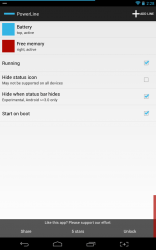 PowerLine is an Android application that redesigns the on-screen indicators for various stats. The information is instead displayed via a minimal line on the edge of the screen. It can be programmed to show battery level, Wi-Fi strength, wireless signal strength, unread messages, storage space and much more. In the free version of the app, you can add up to two indicators on your screen at once.
PowerLine is an Android application that redesigns the on-screen indicators for various stats. The information is instead displayed via a minimal line on the edge of the screen. It can be programmed to show battery level, Wi-Fi strength, wireless signal strength, unread messages, storage space and much more. In the free version of the app, you can add up to two indicators on your screen at once.
Pros
- Display system stats in stylish and minimal way through on-screen indicator lines
- Lines are totally customizable and can be placed in multiple screen locations
- The lines always stay on top, even when playing fullscreen games
- You can pause (hide) the indicator lines instantly with a notification icon
- Uses about 16MB of RAM while running, which is not bad
Cons
- Depending on the position of the indicator lines, they can get in the way of system elements like the tray clock
- Only two indicators can be used at a time in the free version
Discussion
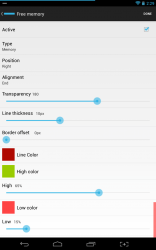 PowerLine actually follows a very straightforward concept. Instead of displaying stats via an icon or indicator, they’re displayed with a solid line on the portion of the screen that you designate. You can have the line placed at the top, bottom or sides of the screen depending on your personal tastes. The application itself includes quite a few customization options that allow you to setup the indicator line exactly how you want it.
PowerLine actually follows a very straightforward concept. Instead of displaying stats via an icon or indicator, they’re displayed with a solid line on the portion of the screen that you designate. You can have the line placed at the top, bottom or sides of the screen depending on your personal tastes. The application itself includes quite a few customization options that allow you to setup the indicator line exactly how you want it.
By default, PowerLine is already configured to display a light blue line at the top of the screen which relates to the remaining battery level. It serves as an obvious sample of what the application can do. Of course, you can remove the default indicator completely if you’d like to display another stat instead. In the free version, you can only display two lines at a time. This limitation is removed in the pro version of the app which is $1.49.
When the lines are configured they will display on screen as you specified. A notification icon is added to the Android tray, which allows you to instantly pause or resume the appearance of the lines. For example, if you were starting a fullscreen game or movie and would like to clear the indicators for a while, you can pause them beforehand via the notification icon.
When you bring up PowerLine, the main screen displays which indicators you have active and several general settings. You can enable or disable the service, hide the Android notification icon, hide it when the status bar hides (Android 3.0 or higher), and start the app when the OS boots. Tapping on an existing indicator allows you to edit the related configuration, and tapping ‘add line’ in the top right allows you to add a new indicator. If you already have two indicator lines active, the application will politely remind you that you’ve reached the limit for the free version of the app.
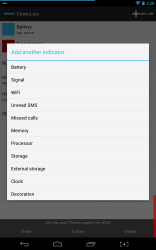 You can add an indicator line to reflect the following elements:
You can add an indicator line to reflect the following elements:
- Battery
- Signal
- WiFi
- Unread SMS
- Missed calls
- Memory
- Processor
- Storage
- External storage
- Clock
- Decoration
When adding a line indicator, you can configure the following options:
- Active- enable or disable
- Type- choose one of the status indicator types (listed above)
- Position (right, left, top, bottom)- screen location
- Alignment (start, center, end) – area of the screen displayed, so if you wanted the line displayed on the bottom right of the screen you would choose right in the option above, and then end
- Transparency
- Line thickness
- Border offset- how close to the edge of the screen the line is displayed
- Line color- the main color of the indicator
- High color- the color when the indicator reaches a high point
- High (percentage)- the minimum percentage for the high point
- Low color- the color when the indicator reaches a low point
- Low (percentage)- the maximum percentage for the low point
 As you can see from the screenshots, you customize the lines, activate them and then leave the app to run in the background. PowerLine uses nearly 16MB of RAM whether you have two different indicator lines active at the same time or one.
As you can see from the screenshots, you customize the lines, activate them and then leave the app to run in the background. PowerLine uses nearly 16MB of RAM whether you have two different indicator lines active at the same time or one.
Lines will remain active even from within fullscreen apps, and the position will remain whether you rotate the device to landscape or portrait viewing modes. If a line is at the top of the display in portrait mode it will also be at the top of the display in landscape mode. Like I said above, you can pause the lines at any time if you don’t want to see them. Personally, I love the fact that they stay on top of all other windows. This allows me to monitor my battery and other stats even while playing fullscreen games. Better yet, the indicators don’t get in the way.
One minor issue is that if you have the lines positioned at the top left of the screen it will cover the clock when you pull down the notification tray. It just looks a little silly is all, but you can still read the clock unless you have the line thickness up high.
Conclusion and download link
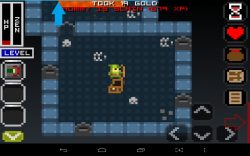 PowerLine is an Android application that allows you to setup minimal, yet customizable, onscreen indicators for various device stats. The more obvious use is to display battery level, but you can also create indicators for wireless signal, missed SMS, memory, storage space, and even just decoration. In the free version you may only display two lines at a time, but this limitation can be removed by purchasing an unlock key ($1.49). I have found that the indicator lines work out great when you’re playing fullscreen games, as you can still monitor battery level and other important stats without taking a break from the action. Furthermore, it uses 16MB of RAM while running which means it isn’t exactly lightweight, but it’s not terrible on resource usage either. Check out this app if you want this type of functionality.
PowerLine is an Android application that allows you to setup minimal, yet customizable, onscreen indicators for various device stats. The more obvious use is to display battery level, but you can also create indicators for wireless signal, missed SMS, memory, storage space, and even just decoration. In the free version you may only display two lines at a time, but this limitation can be removed by purchasing an unlock key ($1.49). I have found that the indicator lines work out great when you’re playing fullscreen games, as you can still monitor battery level and other important stats without taking a break from the action. Furthermore, it uses 16MB of RAM while running which means it isn’t exactly lightweight, but it’s not terrible on resource usage either. Check out this app if you want this type of functionality.
Price: Free, $1.49 (full version license)
Version reviewed: 1.4
Requires: Android 2.1 and up
Download size: 966KB

 Email article
Email article



